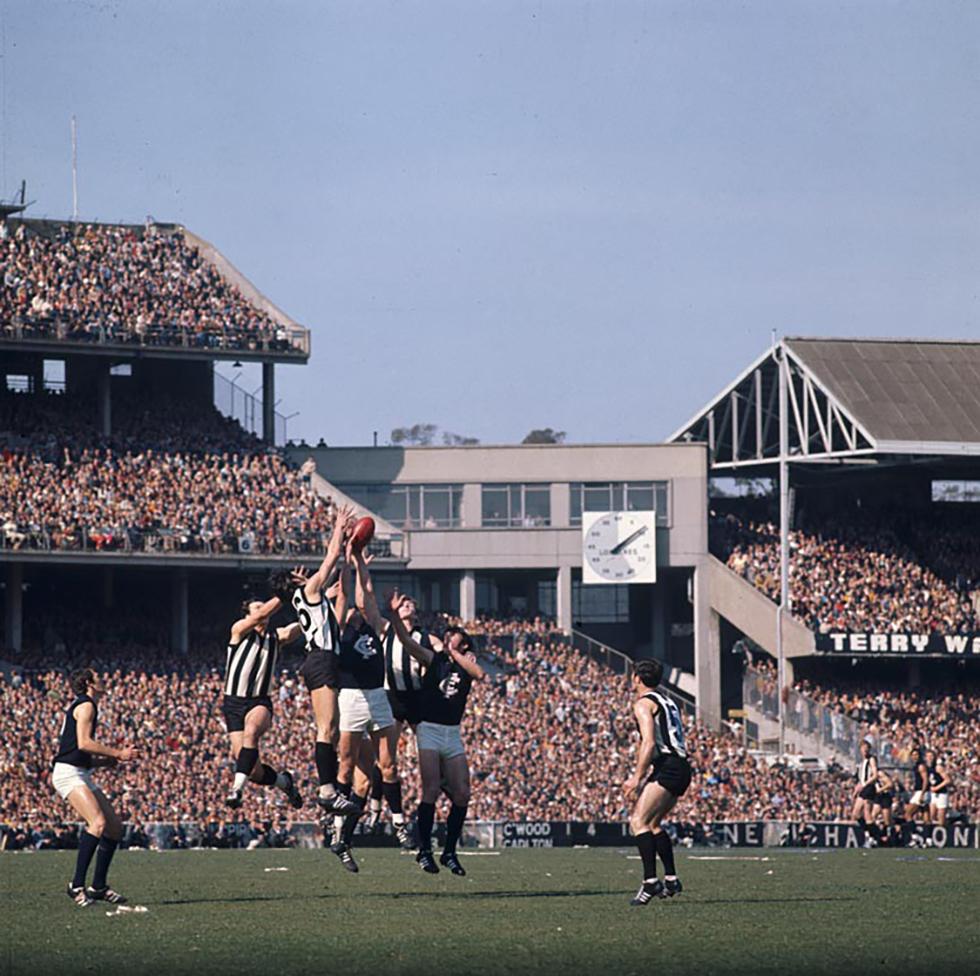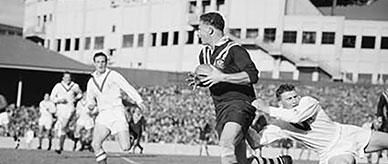


About this record
This colour photograph shows three Collingwood Australian rules football players (in the black-and-white striped jumpers) contesting a mark against three Carlton players (in the navy blue shirts) during the Victorian Football League (VFL) grand final played at the Melbourne Cricket Ground (MCG) on 26 September 1970. The photograph was probably taken during the first quarter, and the packed stands can be seen in the background.
Educational value
- This is a moment in play from what is considered one of the most astonishing VFL grand finals in history, when Carlton came from 44 points behind at half time to defeat Collingwood by 10 points – 111 to 101. Collingwood were strong favourites to win what would have been its 14th VFL flag, having had an outstanding season and defeating Carlton on each of their three encounters, including a decisive victory by 77 points in Round 19.
- The six players in the air are attempting to take a mark – a catch on the full from at least 10 yards (about nine metres) from the kicker – and gain the resultant advantage of an unimpeded kick in any direction. This match was a famous one for marks, especially one taken by Carlton's Alex Jesaulenko (1945– ), that is known today as the mark of the century and led commentator Mike Williamson to shout the famous words still used to describe a towering mark, '... you beauty!'
- While the photograph shows a mark being contested, in fact handballing was a bigger feature of the final's second half. At half time Carlton coach Ron Barassi (1936– ) instructed his players to 'play on' whenever they could, using handballs to keep the ball moving at every opportunity. Barassi had long been thinking about this innovative tactic, and its use in the 1970 grand final is widely regarded as signalling the birth of the contemporary game.
- While packed stands are normal at VFL and Australian Football League (AFL) grand finals, the spectators seen here were part of a crowd of 121,696 people – the greatest number in attendance at a grand final at the MCG. This record is likely to stand, as the MCG's total capacity was reduced to 100,000 in 2002 when work began to demolish and rebuild the Ponsford, Members and Northern stands.
- The photograph was taken by a photographer from the Australian News and Information Bureau (ANIB), an Australian Government organisation set up in 1950 to promote the Australian way of life and Australian events overseas. ANIB photographers travelled to all parts of the country to take photographs of everyday Australian life. Colourful images of a VFL final helped spread information about Australia's own form of football.
- The intense rivalry between Carlton and Collingwood football clubs magnified the importance of this dramatic game, the most memorable of a generation. To many of their fans, the clubs seemed to be complete opposites. Collingwood was seen as a working-class club with a strong Irish Catholic membership. Carlton had come to be seen as an 'establishment' club, with former Prime Minister Sir Robert Menzies (1894–1978) its number one ticket holder in 1970.
Acknowledgments
Learning resource text © Education Services Australia Limited and the National Archives of Australia 2010.
Need help with your research?
Learn how to interpret primary sources, use our collection and more.

